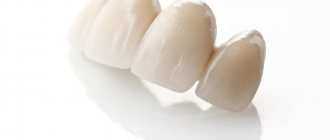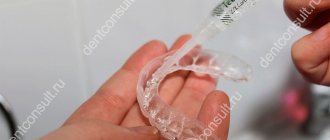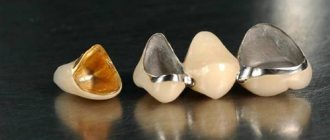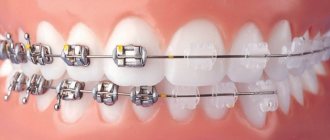- Service life of different types of crowns
- Late crown replacement
- When to change a crown
- How to change crowns
- How often are crowns replaced?
- Additional videos
Sooner or later, most people have to deal with dental prosthetics.
Perhaps the most common type of prosthetics is the so-called “dental crown” (more information about different crowns here). Many patients are their owners, but only a few patients ask questions: do dental crowns need to be replaced, how often should dental crowns be changed, etc.
Let's try to figure it out.
What is a metal-ceramic crown?
Today, the choice of materials for making dental crowns is very wide: ceramics, zirconium dioxide, and plastic, but metal-ceramics continues to be the most popular and affordable. At the moment, metal ceramics are a kind of gold standard in dentistry, since similar designs have been used by doctors for many years and have proven themselves to be good.
Metal-ceramic crowns are a “cap” with machined fissures, which is placed on a ground tooth and completely imitates its shape, including all anatomical formations. The basis for the structure is a metal frame, which is covered on top with a layer of ceramics, indistinguishable in color from natural enamel. The prosthesis is secured to the ground dental tissues using special composite or glass ionomer cement. In case of severe destruction, a metal tab is first installed, which serves as a reliable basis for the crown. Metal-ceramics are also used for the manufacture of bridges and clasp dentures supported both on the patient’s own teeth and on dental implants. In the latter case, the use of implants with metal abutments is recommended.
Pros and cons of a metal-ceramic crown
Among the advantages of metal-ceramic crowns is, first of all, their strength. Therefore, in most cases they are installed on chewing teeth. Undoubtedly, they look much better than purely metal crowns. In general, metal-ceramic crowns imitate real teeth well, but with the advent of new materials in prosthetics, preference in restoring anterior teeth began to be given to all-ceramic structures. When a combination of reliability and aesthetics is needed in the chewing area, then the best choice would be ceramic prostheses based on zirconium dioxide.
Make an appointment
right now!
Akhmedkhanov Said Rashidovich
Surgeon, Therapist, Orthopedist, Hygienist, Implantologist
What are the differences between metal-ceramic crowns?
Indeed, many patients wonder: what is better - zirconium crowns or metal-ceramics? Roughly speaking, both structures are metal-ceramic, but zirconium is a “white” material that does not shine through the ceramic, as sometimes happens with ordinary metal. Therefore, today ceramic crowns on a zirconium frame are close in aesthetic qualities to all-ceramic crowns, but at the same time they have the same strength as metal-ceramics. However, prices for such prostheses are higher than for metal-ceramic structures without the use of zirconium.
The question of which is better - metal-ceramic or ceramic crowns cannot be answered unequivocally. The choice is made depending on the indications and budget. So, if prosthetics of the frontal group of teeth is necessary, it is recommended to choose solid ceramics. It is aesthetic metal ceramics. Typically, such crowns are placed on teeth where the chewing load is less, since the metal-ceramic frame is stronger. Regarding the issue of price, a metal-ceramic crown is, of course, cheaper.
What should I replace the bridge with or what is the alternative?
If a patient has lost one tooth, then he is faced with the question of what to choose to restore the dentition. Typically, your doctor will suggest installing a dental bridge or implant.
Recently, implantation has been considered the most reliable and durable method of restoration, since the “artificial root” cannot be distinguished in the oral cavity from a regular tooth. You can choose a combined option when several teeth are missing in a row. Instead of an abutment tooth, a bridge is installed on an implant.
But the best solution for maintaining oral health is to undergo timely medical examinations, which will allow you not to lose your teeth.
Types of metal-ceramic crowns
Metal-ceramic crowns have several classifications: according to the frame material and according to the ceramic material. Thus, according to the frame material, crowns are distinguished based on a chromium-nickel alloy, based on a cobalt-chromium alloy, and based on a gold-platinum (palladium) alloy (based on the so-called “noble alloys”). There is also another material that is used quite rarely - titanium alloy. Each of these types of metal-ceramic crowns has its own pros and cons. Traditionally, the most popular material is cobalt-chromium alloy. Based on the ceramic material, a distinction is made between conventional (high-temperature) and low-temperature ceramics. Low-temperature ceramics based on “noble” alloys look more aesthetically pleasing.
Indications and contraindications for metal-ceramic crowns
The indications for installing a metal-ceramic crown are the same as for crowns made of other materials. The main one is the index of destruction of the coronal surface of the tooth, equal to 0.6. Also, indications for installing a metal-ceramic crown are:
- any non-carious lesions, for example, fluorosis or enamel hypoplasia;
- abnormal development and position of the front teeth in adults, which for any reason cannot be eliminated by orthodontic methods;
- pathological abrasion or wedge-shaped defect;
- aesthetic defect in the crowns of natural teeth (changes in color and shape, loss of shine, etc.);
- inconsistency of existing artificial crowns with aesthetic and functional requirements;
- metal-ceramic crowns can also be used as a splinting structure for mild to moderate periodontitis;
Each of the above indications should be considered in the context of a specific clinical case. Contraindications include, for example, bruxism, as well as periodontitis, accompanied by severe tooth mobility. In addition, fixed prosthetics on implants also involves the use of metal-ceramic crowns.
Is it possible to put metal-ceramic crowns on the front teeth?
It is possible if the patient’s budget does not allow for all-ceramic crowns. There are no medical contraindications to the manufacture of metal-ceramic crowns on the frontal teeth. However, aesthetics in this case recedes into the background. Such crowns will not look very natural. Therefore, it is still better not to place metal-ceramic crowns on the front teeth.
Installing a metal-ceramic crown on a tooth
- The first stage of installing a metal-ceramic crown can be called clinical. The doctor treats the tooth and its canals, prepares dental tissue for the future crown and takes an impression.
- After this, the laboratory stage begins: in the laboratory, a crown frame is made, which we then try on, check its reliability and fit to the tooth, correct defects, if any, and also choose the color of the future structure. The frame is then taken back to the laboratory, where a technician applies ceramic paste to it.
- When the crown is ready, the doctor invites the patient to an appointment and installs it.
While the prosthesis is being manufactured, which can last from one to two weeks, a temporary crown is installed on the tooth.
Metal-ceramic crown with shoulder
There are no metal-ceramic crowns with a shoulder. The tooth is ground with a shoulder, and the metal-ceramic crown is made with a ceramic shoulder. That is, the edges of the metal frame of the crown are lined with a special “shoulder” ceramic mass. This is done to improve the aesthetics of prosthetics with metal-ceramic crowns, as well as to prevent “cyanosis” (translucency of the metal frame) in the crown-tooth transition zone.
Prosthesis replacement technology
If the need to replace the prosthesis is identified, then the procedure involves performing the following actions:
- Removal of the old crown and production of a temporary prosthesis. It is made using a silicone key.
- Assessment of tooth condition. If the root is in order, then it must be cleaned, processed to give it the correct shape, and also remove possible caries.
- Impressions are taken to make a new crown and sent to a dental laboratory. The duration of production depends on various factors, but in any case, the patient does not walk without a prosthesis. On the same day, a temporary cap is installed.
Upon completion of the crown, the doctor informs the patient about this. At the appointed time, the new prosthesis is installed. All types of products (even the most expensive ones) have a certain resource, so it is important to understand that sooner or later there will be a need to replace them. It is especially important for people with crowns to monitor the condition of the oral cavity and regularly visit the dentist for preventive examinations.
Service life of metal-ceramic crowns
How long does a metal-ceramic crown last? Modern products last on average about 10 – 12 years. If a chip occurs on the metal-ceramic crown of the ceramic layer, then in some cases repair is possible. If it did not occur due to the development of secondary caries under the prosthesis, but as a result of mechanical damage, the dentist assesses the volume of the chip and, if the metal frame is not exposed, restoration of the metal-ceramic crown can be carried out using grinding or composite materials. If a serious chip occurs on the metal-ceramic crown, the prosthesis must be replaced.
Once the service life of the prosthesis has expired, the structure must be replaced. This is due to the fact that the special cement on which the structure is attached begins to deteriorate over time under the influence of saliva and other factors. If the crown is not removed in time, a problem may arise such as secondary caries, developing under the cap and at its junction with the tooth tissue.
What will result from untimely replacement?
People are reluctant to visit dental offices, but if you experience discomfort from a crown, you should immediately contact a specialist. Untimely replacement of the prosthesis threatens the following negative consequences:
- Root destruction - a cap not only allows you to restore the function of a damaged tooth, but also protects its root from further deformation. Over time, the supporting part is negatively affected. The bond is gradually destroyed by the action of saliva, which ultimately contributes to the accumulation of food debris and microbes. It is impossible to remove them with a toothbrush, so the process takes a long time and is asymptomatic. As a result, the root is destroyed, which may subsequently lead to the need to remove it.
- Development of inflammatory processes - inflammatory processes can develop in the gums, which not only cause discomfort, but also lead to more serious consequences. If the prosthesis (especially a low-quality one) is not replaced in a timely manner, you can lose all adjacent teeth.
A dentist, whose visits should be regular, will help you make sure that you need to replace the crown. It is important to understand that it is almost impossible to determine this on your own and, as a rule, patients turn to a specialist already too late.
Caring for metal-ceramic crowns
The rules for caring for metal-ceramic crowns are practically no different from the rules for caring for natural teeth. However, less interdental plaque and tartar are formed on the metal-ceramic surface than on natural enamel. For care, it is necessary to use dental floss, brushes and, preferably, an irrigator to avoid the accumulation of plaque at the transition boundary from the crown to the tooth. During the professional hygiene procedure, the structure must be polished. Otherwise, timely attendance at preventive examinations and thorough daily cleaning will help the metal-ceramic crown serve its full service life.
When is it time to change?
The decision to replace the product can only be made by a specialist based on objective signs.
These include:
- the prosthesis or crown was installed a long time ago and its integrity is compromised;
- no clear fit;
- there are areas of plaque accumulation;
- the presence of signs of inflammatory nature, exposure of the root.
Specific symptoms will help you understand that it is better not to postpone a visit to a specialist.
It is necessary to change the design if:
- the tooth under the crown hurts;
- gums become inflamed;
- an unpleasant odor appeared;
- leftover food gets stuck;
- the system has become mobile;
- the lower jaw protruded forward, it became difficult to bite and chew food.
Postponing a visit to the dental clinic can cause a number of unpleasant consequences.
How much do metal-ceramic crowns cost in Moscow?
The price of metal-ceramic crowns per tooth depends on the price category of the clinic in Moscow, the metal used to make the frame, the qualifications of the prosthetist and dental technician, the complexity of the clinical case and a number of other factors. The price of a metal-ceramic crown for one tooth starts from 7,000 rubles. However, it does not include additional costs. The total cost of a dental crown made of metal ceramics, including taking impressions, installing a temporary crown and fixing a permanent one, is about 10,000 rubles, which, in general, is very inexpensive in Moscow.
Publisher: Expert magazine about dentistry Startsmile.ru
Where to go for dental care in Ivanteevka and Shchelkovo?
If you need a crown, bridge, or implantation services, contact Sanident Comprehensive Dentistry. Our patients have the opportunity to receive a free consultation and undergo treatment at the most affordable price.
Dental prosthetics is one of the dental services provided by the clinic’s specialists at a high level.
Diagnostics and treatment are carried out using modern equipment, using high-quality raw materials. We provide a guarantee for all types of services.









